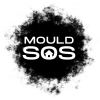The problem with Mould – some simple facts
- Firstly there are approximately 100,000 species of mould identified to-date by science.
- It is therefore of no great value to try to identify mould by its colour. There are many black moulds. There are many white moulds. There are many moulds of every colour you could name. It is further complicated by the fact that the colour of some moulds may vary depending upon the food source it is growing on.
- Biological classification places mould in the kingdom of fungi. Other fungi include mushrooms, toadstools, mildew, puffballs, stinkhorns, jelly moulds, yeasts, rots etc.
- Human eyes are incapable of seeing mould spores without the aid of magnification. When we see mould on a surface we are looking at a colony (a mass of hyphae forming a mycelium). A single square centimetre of penicillium growth is capable of supporting up to 80 million spores.
- Mould spores and fungal fragments can range from 2µm to 20µm (there are 1000µm (microns) in a millimetre). Fungal spores can be bigger. The design of the human eyeball is capable of seeing down to approximately 50µm. Mould spore and hyphal fragments can be as small as 0.3µm.
- Mould spores are the “seeds” of a mould. Mould spores are to mould what pollen is to plants except mould spores are often smaller
- Mould spores are ubiquitous. That means they are everywhere. They are in the air outside, in your home, office, your hair, your clothes….everywhere.
- Mould spore levels will vary from location to location (e.g. if you live near woods or fields) and at different times of day and different times of the year.
- The human body is conditioned to tolerate normal mould levels in the air. We call this level the normal ecological background level. Having said that, some humans show allergy symptoms when pollen levels increase at certain times of year despite the fact that these levels would be considered normal for that time of year.
- Mould does not grow in water but it will grow in high humidity or damp conditions e.g. It does not grow in dry conditions. Remember that a room can be relatively dry but if the humidity on a material surface is high, mould may grow.
- Our buildings should be dry enough not to support mould. If you have mould growing in your building, your building has a damp problem.
- There are many causes of damp in a building.
- Mould growth in an enclosed structure will result in elevated levels of spores on surfaces and in the air.
- Particles as small as mould can defy gravity and remain suspended in the air indefinitely due to the resistance of the air in its attempt to fall to the ground. (This is an example of “Brownian Motion”).
- Moving the air near mould spores will send the spores into the air. This includes the motions we make in misguided cleaning attempts.
- You can kill off the mould growth with cleaning but you will have spread all the spores and hyphal fragments. Any spores surviving the chemistry that we attack it with, or a new supply of spores carried around on the air, will grow again if the surface remains damp when they land on that surface.
- Mould spores, whether living or dead, are a hazard to human health. Even spores that have been chemically damaged so they can never re-produce through germination and growth are still potentially respirable, allergenic and may contain toxins depending which species they are.
- When mould growth detects a competing colony (mould competes for food as do most organisms on this planet) it will produce gases to defend itself and ward off the competition. Some moulds will produce gases which are toxic to humans. Cleaning mould with disinfectants or bleaches will induce the same defence reaction.
- The amount of mould spores, or toxins produced by moulds, required to trigger a response from a human being is unknown as each and every person on the planet has a unique immunology. Some people will be harmed much sooner than others. Some will require much longer exposure than others. Think of peanut allergies, pollen allergies or for that matter any allergy. At what point is a response triggered by these?
- There are another estimated 200,000 to 1.5 million species of mould expected to be discovered and named by science.
With a complete lack of knowledge, the average consumer or “cleaner” has no idea of the above and when mould is “cleaned up”, they usually make it much worse and expose themselves, colleagues and occupants to elevated levels of spore, hyphal fragment and toxin inhalation.
“Poor Remediation is worse than no remediation at all”
To make things worse, a tradesman or contractor may have been in breach of Health and Safety regulations which may be a criminal act by any or all those responsible for failing in their duty to deliver a competent person to the job. That could go up chain all the way to the loss adjuster and insurer in an insurance claim supply chain.
Mould – A Health Hazard
There are those who argue that many of the reported symptoms of people who claim they are sick from mould are either imagining their problems or that the symptoms are as a result of a different cause.
Whilst it is the belief of the author that the evidence is overwhelming against this view, it actually does not matter what they believe.
Health and Safety law in the UK is clear:
- Control of Substances Hazardous to Health (COSHH) Regulations 2002 (revised 2013) refer to fungi as asthmagens. (COSHH Regulations fall under the Health and Safety at Work Act 1974.)
- The Health and Safety Executive (HSE) publication “The Approved List of Biological Agents” supporting COSHH and referenced by COSHH lists 8 entire genera of moulds (potentially hundreds of species within each genera) and 39 individual species in human pathogen hazard group 2 and hazard group 3. It does not mention moulds which are toxigenic e.g. the “black mould” most people have heard about which is stachybotrys chartarum nor does it mention penicillium chrysogenum which is used in medicine because of its toxicity to bacteria but is also toxic to some humans. The list is essentially incomplete which is acknowledged in the introductory pages.
- COSHH and The List of Approved Biological Agents both state that if there is a substance that is believed to have the potential to harm people, it should be treated as harmful.
Furthermore…
- World Health Organisation guidelines for indoor air quality and damp describe mould as a health hazard – http://www.who.int/occupational_health/publications/airdust/en/
- Healthy Housing Safety Rating System refers to mould as a health hazard.
- National Health Service publications list mould as a health hazard – http://www.nhs.uk/chq/pages/can-damp-and-mould-affect-my-health.aspx
In summary:
- Some moulds are pathogenic
- Some moulds are toxigenic
- All moulds are allergenic
- All moulds are asthmagenic
There is also evidence that some mould toxins are:
- Mutagenic (affecting unborn babies)
- Carcinogenic (cancer causing)
- Estrogenic (affecting human reproductive systems)
Some mould will be two or more of the above hazards
Mould has the capacity to make people sick. It is a one of the contributing factors to what is known as SBS “Sick Building Syndrome” or BRI “Building Related Illness”.
Remember, the Health and Safety at Work Act 1974 and its regulations apply to all work carried out in a house as well as any commercial building. This applies to volunteers working for charities as well as tradesmen and contractors.
Mould Removal Advice
NHS documents claim that if you are prepared to remove mould growth yourself in your own home, you should not do so when the growth exceeds 1m² and that you should call in a professional service.
A professional mould remediator MUST be competent (i.e. trained in the task they are performing) and that means understanding mould is a hazardous material.
A professional mould remediator MUST carry out appropriate RISK ASSESSMENT and take appropriate CONTROL MEASURES.
A professional, trained and competent remediator will, amongst other things, need to consider:
- Whether sampling, testing or speciation is required and how much is required
- What containment measures are required and how to set it up
- What air filtration and air exchange is required
- What level of Personal Protective Equipment (PPE) is required
- What level of clearance testing is required and whether an independent 3rd party environmental hygienist should do it
Please note that if visible mould is present, it is not always necessary to sample it for identification. It is a hazard. Full stop.
Our Services
In addition to our training and education activities, The Restoration Academy UK Limited offer a consultancy service which:
- investigates mould claims for
- Loss adjusters
- Loss assessors
- Home owners
- Tenants
- Landlords
- Water damage restoration companies
- Cleaning companies
- Commercial properties
- Public buildings
- advises, landlords and tenants of their obligations under Landlord and Tenant Act 1985 and Occupiers Liability Act 1957
- advises on how works should be carried out
- carries out clearance testing following decontamination and cleaning and before any drying procedures
- carries out clearance testing for final post-remediation (drying) certification.










